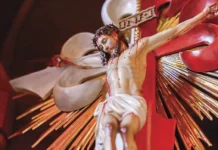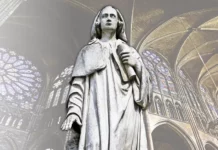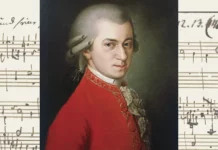A keen observer of reality, perspectives and human types, Canaletto was able to magnificently reflect in his paintings 18th-century Venice, an old and worn but still-charming city.

Giovanni Antonio Canal, nicknamed Canaletto
Giovanni Antonio Canal opened his eyes to the world in Venice on October 18, 1697.
Little Canal, nicknamed Canaletto, a creative, vivacious and perceptive – in a word, Venetian – spirit, was an artist from the cradle. His father, Bernardo Canal, was a painter who made his living behind the scenes of important European theatres as a scenographer and decorator. It was in his father’s studio that he learned to paint, quickly becoming so skilled with the brushes that he was soon decorating in Venice and later in Rome, together with his father.
Scenography was no small thing. Perhaps it was even considered to transcend art, such was the enchantment and deception it produced among spectators, awed by the fascinating scenes that seemed to have emerged from a fairy-tale world.
Such a profession required knowledge in a variety of fields, including engineering, to design hangings and structures; carpentry, to erect veritable cities on immense stages; painting, to open skies in closed ceilings and simulate distant horizons glimpsed from under arches and through half-open doors. However, the essential attribute of a scenographer was undoubtedly genius, that gratuitous gift by which the dreamer becomes a creator, capable of bringing unimaginable wonders from Paradise down to this mortal world.
The beginning of a career
Antonio Canal soon decided to follow a different path from his father. Building on what that he had learned with the latter, he chose pursue the world of painting, attracted by the beauty of the Roman ruins and later by the graceful grandeur of his home city. Perspicacious observer of reality, perspectives, colours and human types, the young man wasted no time, fascinated by every new angle he encountered.
He was of medium height, with a thick head of hair, in keeping with the fashion of the time. He had rounded features with a few sharp traits, a lively gaze, an energetic and entrepreneurial spirit, yet with a gentle and refined manner, as suggested by Antonio Visentini’s portrait.
Walking up and down all of Venice, he contemplated the streets, alleys, windows, terraces and rooftops of the old city, worn out but still so arresting and charming. In the 18th century, the splendid heyday of La Serenissima had already passed, and it was no longer the dominant maritime economy that posed for the talents of that promising artist, full of hope in the future of his career, but a light-hearted Venice which, inversely proportional to its military and economic decline, was ever more opulent in its festivities.
The famous Carnival, for example, with its masquerade balls and multi-coloured, luxurious and heterogeneous parades, mingling eminent patricians with simple gondoliers, was a spectacle renowned throughout the civilized world, which “for six months attracted an influx of foreigners to Venice that reached thirty thousand in number.”1
In this society with such a thirst for the arts and, at the same time, such fertile ground for them, Canaletto began his compositions. Together with his nephew Bernardo Bellotto,2 he completed his first works. To this day it is not known whether he or Bellotto was the actual author of some paintings from this early period of Canaletto’s career, given that his nephew’s style was so similar to his own.
Canaletto’s works – oil paintings, engravings and watercolours – began to make a name for themselves in the world of art, which at that time also meant in the world of commerce, and it was not long before he was recognised by many patrons as one of the greatest figures in vedutism.3
Canaletto’s Venice
As if his outstanding artistic genius was not enough, Canaletto chose subjects that guaranteed, in themselves, the originality of his paintings. While some authors presented an inordinately fabulous Venice, immersed in eternal ceremonies of exuberant and tumultuous multitudes, or lined up in battle array in the manner of tin soldiers, Canaletto most often sought nothing more than the reality of the “everyday” Venice[4], with its simplicity and its charm; the reminders of its grandeur engraved on each wall, arch, column and window.
As a good photographer does today, he knew how to be discreet, to stand behind the columns of a gallery or a street vendor’s tent in St. Mark’s Square, or even to analyse from afar a group of bourgeois in lively conversation, in order to capture people in their natural and spontaneous interactions. For each setting he chose the best perspective, but he also studied the populace who were part of it, giving life and movement to the scene.
It is enough to look carefully at some of his canvases to be fascinated by the wealth of details. In one corner, a young gentleman, somewhat intrigued, assesses the products for sale scattered over the tiles of the square. A little further on, a group of aristocrats are conversing and gesticulating animatedly, perhaps discussing politics and economy or the rain and good weather. Nearby, a merchant presents his precious frames and tapestries, propped against the wall of a building or hanging from an improvised structure, to a distinguished lady with her characteristic hoop skirt.
The observer, captivated and almost compelled to stroll through the universe of the composition’s details, can almost hear the commotion of the fair, the cries of the gondoliers, the open-air theatres and the barking of some stray dog wandering among the street vendors. The pages of Canaletto’s notebook are still preserved today, where we can contemplate a very rich collection of personalities, captured live, which he “catalogued” for use in his various landscapes, placing them wherever he wished.
But it is also true that Canaletto knew how to paint the feast days and solemnities, sometimes civil, sometimes religious, as no one else could. His brush was able to transmit in a unique manner something of the pomp, vivacity and joy that inundated Venice on those festive days, which, in fact, were not few. Indeed, “the election of a doge, the news of a victory, the visit of a foreign prince, all served as a pretext for organizing this spectacle whose staging was truly marvellous.”5
One of his most famous compositions portrays the solemn day on which, on the date of the Ascension, the Doge of Venice annually renewed the so-called “marriage” of La Serenissima with the sea, by means of the nautical parade of the Bucentaur – an immense vessel, without masts or sails, entirely overlaid with gold – accompanied by countless boats of every shape and size that human genius dared to devise, along with an even richer array of people.

Ten years in England
The 18th century brought a great influx of young people from the British aristocracy to Venice. They soon became a fruitful clientele for Canaletto, so that his fame, already growing in his home city, spread also among the English nobility, who began to acquire his paintings. They saw his achievements on canvas as unprecedented, combining such precision and realism with such beauty. Joseph Smith, a British consul and admirer of the arts, commissioned and sold a great number of the artist’s works, many of which are now displayed in palace-museums in England.
In 1746, Canaletto moved to London. Regarding his stay on the island, once called “of the Saints,” it suffices to say that Canaletto saw England through the eyes of a Venetian, overlaying its landscapes with a certain vibrancy and a tonality not entirely typical to that corner of the world, while always remaining faithful to reality.
The great event of the time in London served, more than once, as a motif for his brush: the construction of the Westminster Bridge, the second to be built on the famous Thames River. In the work London seen through an arch of Westminster Bridge, the keen observer will contemplate, with some curiosity, a detail: in the foreground, a bucket hanging by a rope. It would never occur to an Englishman to make such an unexpected addition to a painting, but for those acquainted with the Italian’s nature, this was no surprise; he was always looking for picturesque incidentals.
Lodging from house to house, he was not lacking in admirers or patrons throughout his trip. Invited by some noblemen to the countryside, far from the capital, he was able to discover subjects more in keeping with his luminous and dynamic style, which was perhaps not so well fitted to the pallid, dense and static fog of London.

the last work and last words that have come down to us from Canaletto
Return to Venice and the consummation of his work
After ten years in England, Canaletto returned to his homeland around 1755. In Venice, he continued to find enthusiastic clients, but now fewer in number. Thus, he spent the rest of his life providing services here and there, for a middle-class or a noble patron, garnering both praise and criticism, always received with much self-assurance.
He painted many other works until, approaching the end of his career, he was accepted into the Accademia Veneziana di Pittura e Scultura, not without difficulty and merit. His election, in September 1763,6 was subject to heated debate, since vedutism was considered an art of lesser value because it adhered too rigidly to reality.
His work of admission was approved by the authorities of the world of painting. It was a capriccio, a style of painting whose motif seeks to combine reality and fiction, unlike the vedute with which he was more accustomed. The painting was a great success and was exhibited in the St. Mark’s Square in 1777, to honour its author.7
The last work that has come to us dates from 1766. It represents a group of singers inside St. Mark’s Basilica, and impresses for the beauty and precision of the lines. One can read at the bottom his signature and the following observation: “I completed this painting […] at sixty-eight years of age, without the aid of glasses, in 1766.”8 These were his last words for history, which allow us to catch a whiff of the perfume of his genius and good humour. No further details are known about the end of his life, except that he surrendered his soul to God on April 19, 1768 and was buried in the Church of San Lio in Venice, his name being forever united with that of this enchanting city. ◊
Notes
1 MOUREAU, Adrien. Les artistes célèbres. Antonio Canal, dit le Canaletto. Paris: Librairie de L’Art, 1894, p.10.
2 Bernardo Bellotto (1721-1780) was later invited by Empress Maria Teresa to Austria, and by King Stanislaw Poniatowski to Poland. His paintings, even more than those of his uncle, are characterized by such architectural and geometric precision that after the Second World War the city of Warsaw could be rebuilt thanks to the canvases of the painter.
3 From the Italian veduta – vedute in the plural – meaning view, that which one sees. It was the established name in the eighteenth century for a style of painting focussing on urban themes, also called cityscape.
4 PEMBERTON-PIGOTT, Viola. The Development of Canaletto’s Painting Technique. In: BAETJER, Katharine; LINKS, J. G. (Org.). Canaletto. New York: The Metropolitan Museum of Art, 1989, p.60.
5 MOUREAU, op. cit., p.50.
6 Cf. BAETJER; LINKS, op. cit., p.267.
7 Cf. Idem, p.276.
8 Idem, p.358.







